Okinawan vs Filipino Community Comparison
COMPARE
Okinawan
Filipino
Social Comparison
Social Comparison
Okinawans
Filipinos
8,907
SOCIAL INDEX
86.5/ 100
SOCIAL RATING
39th/ 347
SOCIAL RANK
9,951
SOCIAL INDEX
97.0/ 100
SOCIAL RATING
5th/ 347
SOCIAL RANK
Filipino Integration in Okinawan Communities
The statistical analysis conducted on geographies consisting of 67,718,108 people shows a moderate positive correlation between the proportion of Filipinos within Okinawan communities in the United States with a correlation coefficient (R) of 0.427. On average, for every 1% (one percent) increase in Okinawans within a typical geography, there is an increase of 0.518% in Filipinos. To illustrate, in a geography comprising of 100,000 individuals, a rise of 1,000 Okinawans corresponds to an increase of 518.1 Filipinos.
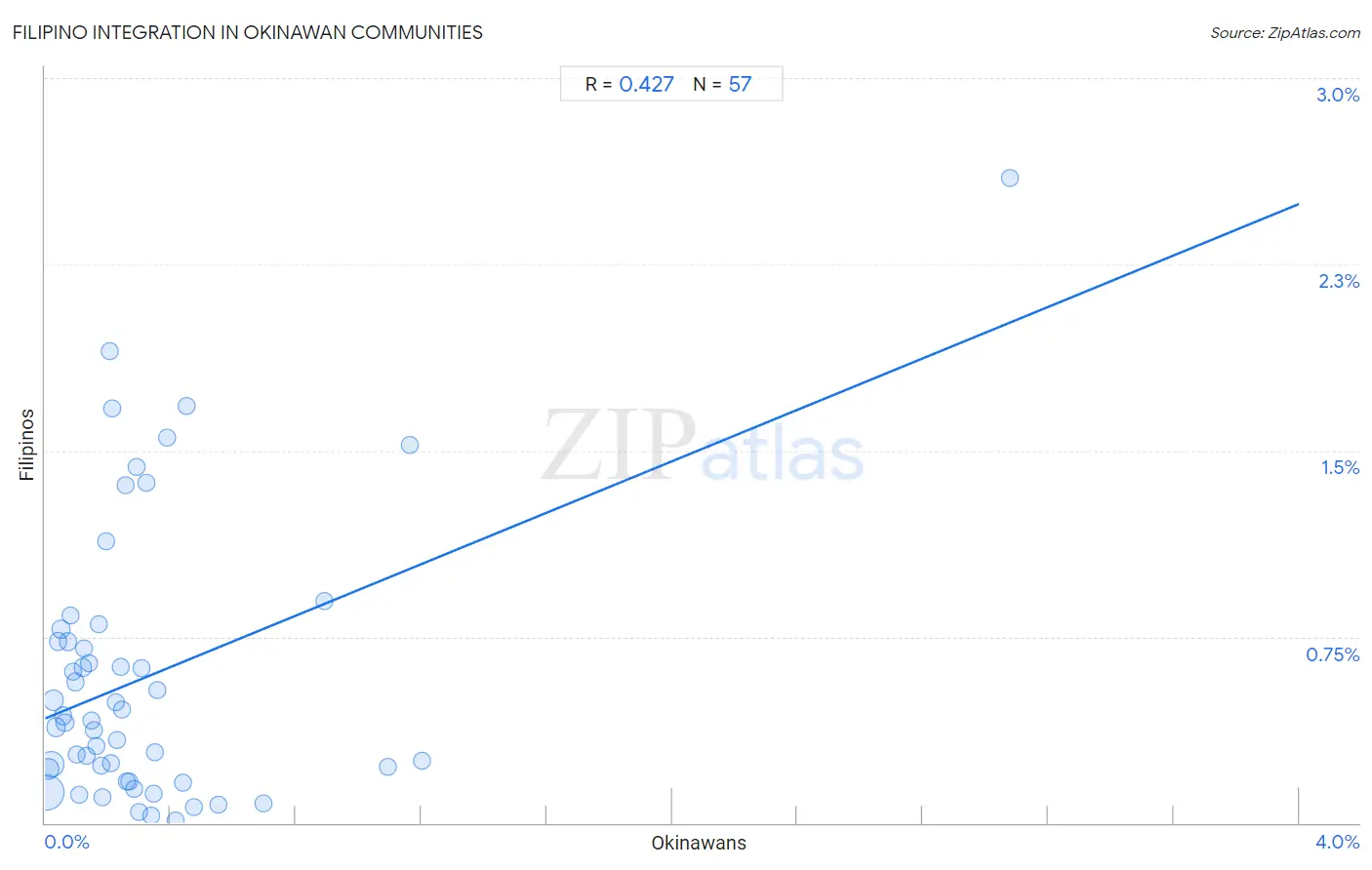
Okinawan vs Filipino Income
When considering income, the most significant differences between Okinawan and Filipino communities in the United States are seen in median male earnings ($67,232 compared to $74,224, a difference of 10.4%), median household income ($106,624 compared to $115,509, a difference of 8.3%), and householder income over 65 years ($70,846 compared to $76,686, a difference of 8.2%). Conversely, both communities are more comparable in terms of median female earnings ($46,905 compared to $49,508, a difference of 5.6%), householder income under 25 years ($54,701 compared to $57,740, a difference of 5.6%), and wage/income gap (28.1% compared to 29.7%, a difference of 5.6%).

| Income Metric | Okinawan | Filipino |
| Per Capita Income | Exceptional $55,817 | Exceptional $59,066 |
| Median Family Income | Exceptional $129,979 | Exceptional $138,397 |
| Median Household Income | Exceptional $106,624 | Exceptional $115,509 |
| Median Earnings | Exceptional $57,550 | Exceptional $61,197 |
| Median Male Earnings | Exceptional $67,232 | Exceptional $74,224 |
| Median Female Earnings | Exceptional $46,905 | Exceptional $49,508 |
| Householder Age | Under 25 years | Exceptional $54,701 | Exceptional $57,740 |
| Householder Age | 25 - 44 years | Exceptional $119,349 | Exceptional $128,723 |
| Householder Age | 45 - 64 years | Exceptional $124,796 | Exceptional $134,910 |
| Householder Age | Over 65 years | Exceptional $70,846 | Exceptional $76,686 |
| Wage/Income Gap | Tragic 28.1% | Tragic 29.7% |
Okinawan vs Filipino Poverty
When considering poverty, the most significant differences between Okinawan and Filipino communities in the United States are seen in child poverty among boys under 16 (13.5% compared to 11.1%, a difference of 21.4%), receiving food stamps (8.9% compared to 7.4%, a difference of 20.0%), and single male poverty (12.6% compared to 10.6%, a difference of 18.6%). Conversely, both communities are more comparable in terms of single father poverty (14.6% compared to 14.0%, a difference of 4.4%), seniors poverty over the age of 75 (12.1% compared to 11.4%, a difference of 6.1%), and seniors poverty over the age of 65 (10.4% compared to 9.7%, a difference of 6.2%).
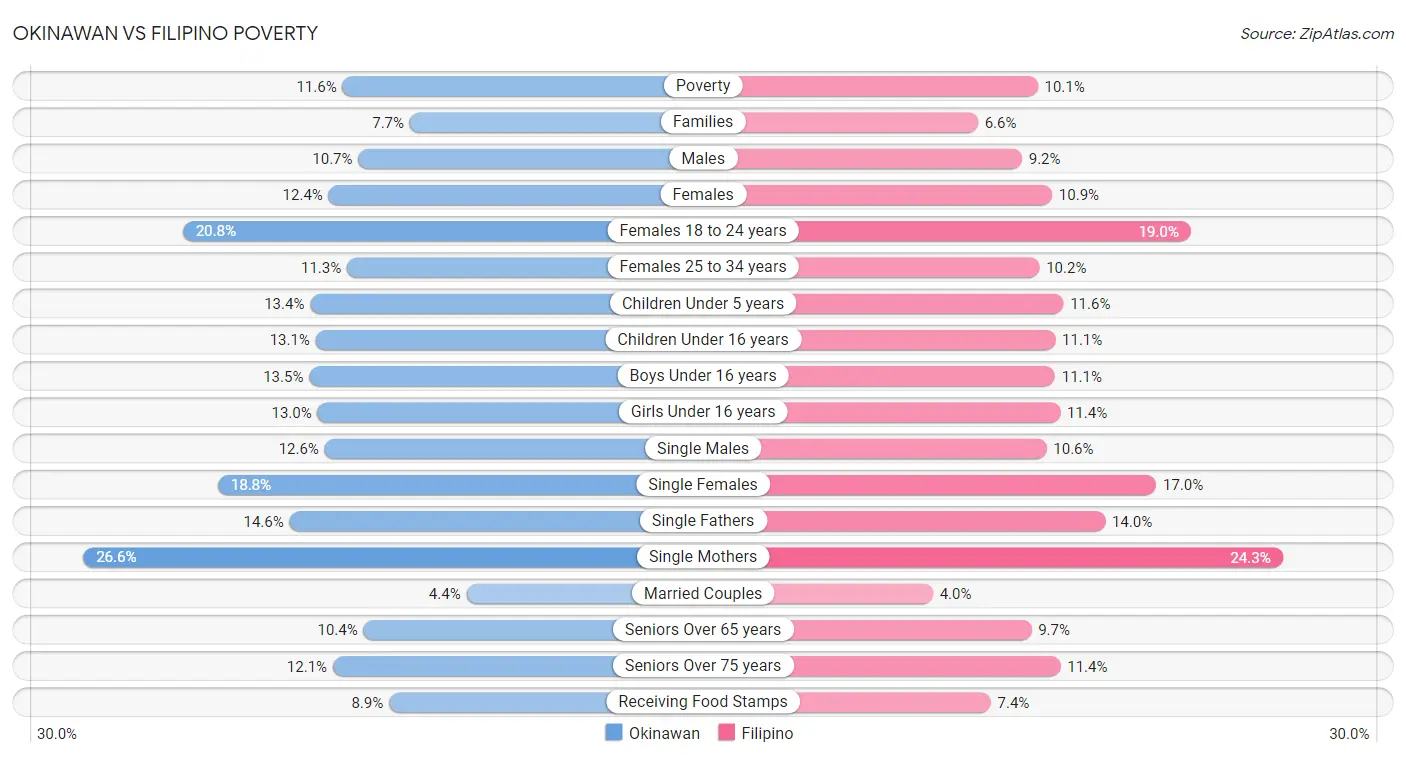
| Poverty Metric | Okinawan | Filipino |
| Poverty | Exceptional 11.6% | Exceptional 10.1% |
| Families | Exceptional 7.7% | Exceptional 6.6% |
| Males | Excellent 10.7% | Exceptional 9.2% |
| Females | Exceptional 12.4% | Exceptional 10.9% |
| Females 18 to 24 years | Tragic 20.8% | Exceptional 19.0% |
| Females 25 to 34 years | Exceptional 11.3% | Exceptional 10.2% |
| Children Under 5 years | Exceptional 13.4% | Exceptional 11.6% |
| Children Under 16 years | Exceptional 13.1% | Exceptional 11.1% |
| Boys Under 16 years | Exceptional 13.5% | Exceptional 11.1% |
| Girls Under 16 years | Exceptional 13.0% | Exceptional 11.4% |
| Single Males | Good 12.6% | Exceptional 10.6% |
| Single Females | Exceptional 18.8% | Exceptional 17.0% |
| Single Fathers | Exceptional 14.6% | Exceptional 14.0% |
| Single Mothers | Exceptional 26.6% | Exceptional 24.3% |
| Married Couples | Exceptional 4.4% | Exceptional 4.0% |
| Seniors Over 65 years | Exceptional 10.4% | Exceptional 9.7% |
| Seniors Over 75 years | Average 12.1% | Exceptional 11.4% |
| Receiving Food Stamps | Exceptional 8.9% | Exceptional 7.4% |
Okinawan vs Filipino Unemployment
When considering unemployment, the most significant differences between Okinawan and Filipino communities in the United States are seen in unemployment among seniors over 75 years (8.8% compared to 7.9%, a difference of 12.3%), unemployment among ages 35 to 44 years (4.4% compared to 4.0%, a difference of 8.2%), and unemployment among women with children ages 6 to 17 years (7.0% compared to 7.6%, a difference of 7.5%). Conversely, both communities are more comparable in terms of unemployment among ages 65 to 74 years (5.2% compared to 5.2%, a difference of 0.010%), unemployment among ages 30 to 34 years (4.8% compared to 4.8%, a difference of 0.39%), and unemployment among women with children under 18 years (4.7% compared to 4.8%, a difference of 0.46%).
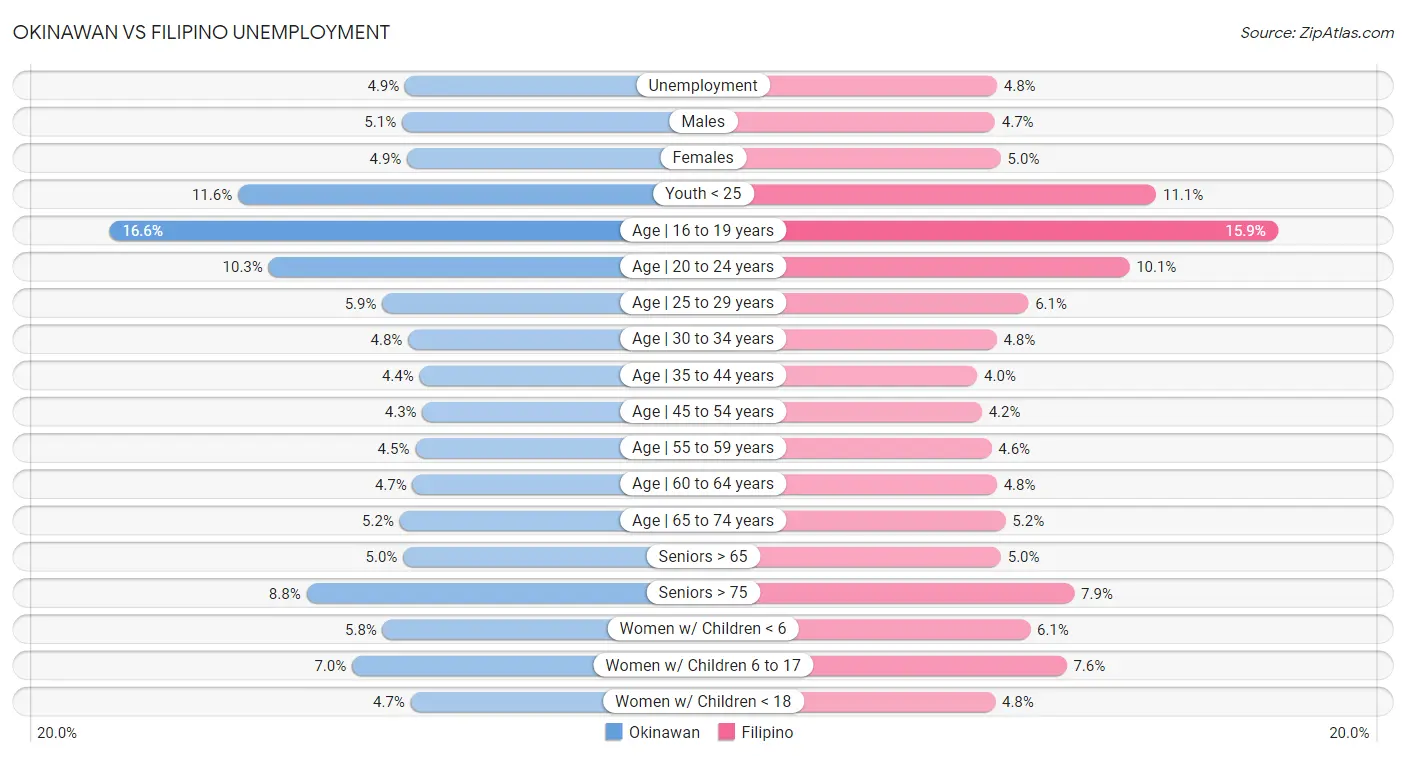
| Unemployment Metric | Okinawan | Filipino |
| Unemployment | Exceptional 4.9% | Exceptional 4.8% |
| Males | Exceptional 5.1% | Exceptional 4.7% |
| Females | Exceptional 4.9% | Exceptional 5.0% |
| Youth < 25 | Average 11.6% | Exceptional 11.1% |
| Age | 16 to 19 years | Exceptional 16.6% | Exceptional 15.9% |
| Age | 20 to 24 years | Fair 10.3% | Exceptional 10.1% |
| Age | 25 to 29 years | Exceptional 5.9% | Exceptional 6.1% |
| Age | 30 to 34 years | Exceptional 4.8% | Exceptional 4.8% |
| Age | 35 to 44 years | Exceptional 4.4% | Exceptional 4.0% |
| Age | 45 to 54 years | Exceptional 4.3% | Exceptional 4.2% |
| Age | 55 to 59 years | Exceptional 4.5% | Exceptional 4.6% |
| Age | 60 to 64 years | Exceptional 4.7% | Good 4.8% |
| Age | 65 to 74 years | Exceptional 5.2% | Exceptional 5.2% |
| Seniors > 65 | Exceptional 5.0% | Exceptional 5.0% |
| Seniors > 75 | Fair 8.8% | Exceptional 7.9% |
| Women w/ Children < 6 | Exceptional 5.8% | Exceptional 6.1% |
| Women w/ Children 6 to 17 | Exceptional 7.0% | Exceptional 7.6% |
| Women w/ Children < 18 | Exceptional 4.7% | Exceptional 4.8% |
Okinawan vs Filipino Labor Participation
When considering labor participation, the most significant differences between Okinawan and Filipino communities in the United States are seen in in labor force | age 16-19 (32.8% compared to 31.7%, a difference of 3.6%), in labor force | age 20-24 (72.7% compared to 71.4%, a difference of 1.8%), and in labor force | age 30-34 (84.6% compared to 85.5%, a difference of 1.0%). Conversely, both communities are more comparable in terms of in labor force | age > 16 (65.9% compared to 65.9%, a difference of 0.050%), in labor force | age 35-44 (84.5% compared to 84.7%, a difference of 0.27%), and in labor force | age 25-29 (85.2% compared to 84.9%, a difference of 0.29%).

| Labor Participation Metric | Okinawan | Filipino |
| In Labor Force | Age > 16 | Exceptional 65.9% | Exceptional 65.9% |
| In Labor Force | Age 20-64 | Good 79.6% | Exceptional 80.1% |
| In Labor Force | Age 16-19 | Tragic 32.8% | Tragic 31.7% |
| In Labor Force | Age 20-24 | Tragic 72.7% | Tragic 71.4% |
| In Labor Force | Age 25-29 | Exceptional 85.2% | Excellent 84.9% |
| In Labor Force | Age 30-34 | Average 84.6% | Exceptional 85.5% |
| In Labor Force | Age 35-44 | Good 84.5% | Exceptional 84.7% |
| In Labor Force | Age 45-54 | Good 83.0% | Exceptional 83.5% |
Okinawan vs Filipino Family Structure
When considering family structure, the most significant differences between Okinawan and Filipino communities in the United States are seen in births to unmarried women (26.9% compared to 23.0%, a difference of 17.2%), married-couple households (47.4% compared to 51.0%, a difference of 7.5%), and single mother households (5.0% compared to 4.7%, a difference of 6.7%). Conversely, both communities are more comparable in terms of average family size (3.15 compared to 3.20, a difference of 1.6%), single father households (1.9% compared to 1.8%, a difference of 2.8%), and currently married (47.4% compared to 49.7%, a difference of 5.0%).

| Family Structure Metric | Okinawan | Filipino |
| Family Households | Tragic 62.5% | Exceptional 65.9% |
| Family Households with Children | Poor 27.2% | Exceptional 28.6% |
| Married-couple Households | Exceptional 47.4% | Exceptional 51.0% |
| Average Family Size | Tragic 3.15 | Poor 3.20 |
| Single Father Households | Exceptional 1.9% | Exceptional 1.8% |
| Single Mother Households | Exceptional 5.0% | Exceptional 4.7% |
| Currently Married | Excellent 47.4% | Exceptional 49.7% |
| Divorced or Separated | Exceptional 10.5% | Exceptional 9.9% |
| Births to Unmarried Women | Exceptional 26.9% | Exceptional 23.0% |
Okinawan vs Filipino Vehicle Availability
When considering vehicle availability, the most significant differences between Okinawan and Filipino communities in the United States are seen in no vehicles in household (14.1% compared to 10.4%, a difference of 35.2%), 4 or more vehicles in household (5.5% compared to 6.9%, a difference of 25.3%), and 3 or more vehicles in household (17.4% compared to 20.8%, a difference of 19.1%). Conversely, both communities are more comparable in terms of 1 or more vehicles in household (86.1% compared to 89.7%, a difference of 4.2%), 2 or more vehicles in household (51.2% compared to 57.8%, a difference of 12.9%), and 3 or more vehicles in household (17.4% compared to 20.8%, a difference of 19.1%).

| Vehicle Availability Metric | Okinawan | Filipino |
| No Vehicles Available | Tragic 14.1% | Average 10.4% |
| 1+ Vehicles Available | Tragic 86.1% | Average 89.7% |
| 2+ Vehicles Available | Tragic 51.2% | Exceptional 57.8% |
| 3+ Vehicles Available | Tragic 17.4% | Exceptional 20.8% |
| 4+ Vehicles Available | Tragic 5.5% | Exceptional 6.9% |
Okinawan vs Filipino Education Level
When considering education level, the most significant differences between Okinawan and Filipino communities in the United States are seen in no schooling completed (1.8% compared to 2.0%, a difference of 6.6%), doctorate degree (3.3% compared to 3.4%, a difference of 4.7%), and bachelor's degree (50.5% compared to 52.7%, a difference of 4.3%). Conversely, both communities are more comparable in terms of 9th grade (95.7% compared to 95.6%, a difference of 0.070%), 10th grade (94.8% compared to 94.8%, a difference of 0.070%), and 6th grade (97.4% compared to 97.3%, a difference of 0.080%).
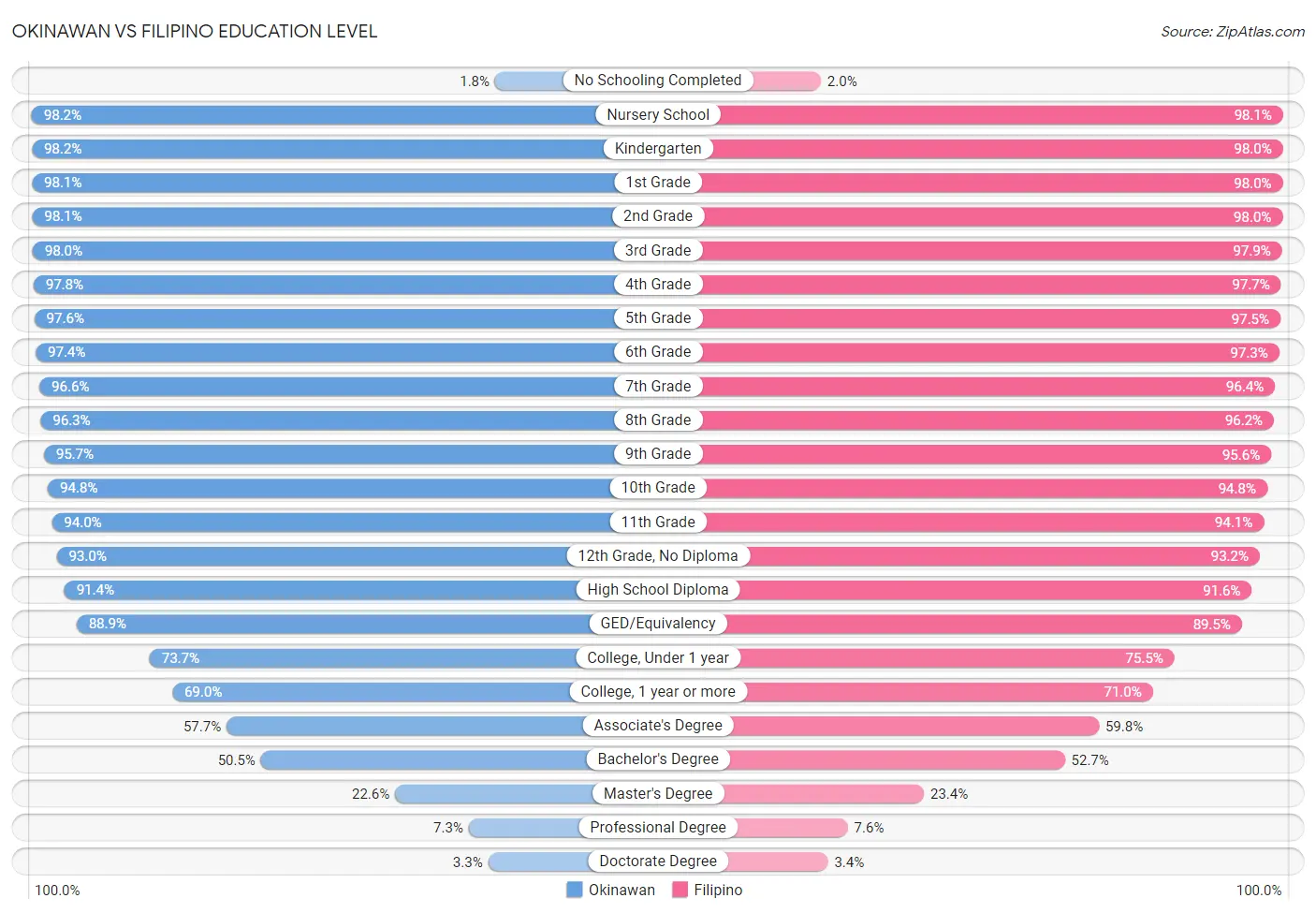
| Education Level Metric | Okinawan | Filipino |
| No Schooling Completed | Exceptional 1.8% | Excellent 2.0% |
| Nursery School | Exceptional 98.2% | Good 98.1% |
| Kindergarten | Exceptional 98.2% | Good 98.0% |
| 1st Grade | Exceptional 98.1% | Good 98.0% |
| 2nd Grade | Exceptional 98.1% | Good 98.0% |
| 3rd Grade | Exceptional 98.0% | Good 97.9% |
| 4th Grade | Exceptional 97.8% | Excellent 97.7% |
| 5th Grade | Exceptional 97.6% | Excellent 97.5% |
| 6th Grade | Exceptional 97.4% | Excellent 97.3% |
| 7th Grade | Exceptional 96.6% | Exceptional 96.4% |
| 8th Grade | Exceptional 96.3% | Exceptional 96.2% |
| 9th Grade | Exceptional 95.7% | Exceptional 95.6% |
| 10th Grade | Exceptional 94.8% | Exceptional 94.8% |
| 11th Grade | Exceptional 94.0% | Exceptional 94.1% |
| 12th Grade, No Diploma | Exceptional 93.0% | Exceptional 93.2% |
| High School Diploma | Exceptional 91.4% | Exceptional 91.6% |
| GED/Equivalency | Exceptional 88.9% | Exceptional 89.5% |
| College, Under 1 year | Exceptional 73.7% | Exceptional 75.5% |
| College, 1 year or more | Exceptional 69.0% | Exceptional 71.0% |
| Associate's Degree | Exceptional 57.7% | Exceptional 59.8% |
| Bachelor's Degree | Exceptional 50.5% | Exceptional 52.7% |
| Master's Degree | Exceptional 22.6% | Exceptional 23.4% |
| Professional Degree | Exceptional 7.3% | Exceptional 7.6% |
| Doctorate Degree | Exceptional 3.3% | Exceptional 3.4% |
Okinawan vs Filipino Disability
When considering disability, the most significant differences between Okinawan and Filipino communities in the United States are seen in disability age 35 to 64 (9.4% compared to 8.0%, a difference of 16.3%), disability age 5 to 17 (5.0% compared to 4.3%, a difference of 15.6%), and disability age 65 to 74 (20.7% compared to 19.0%, a difference of 8.9%). Conversely, both communities are more comparable in terms of hearing disability (2.6% compared to 2.6%, a difference of 0.39%), disability age over 75 (44.9% compared to 45.4%, a difference of 1.2%), and self-care disability (2.2% compared to 2.2%, a difference of 2.0%).
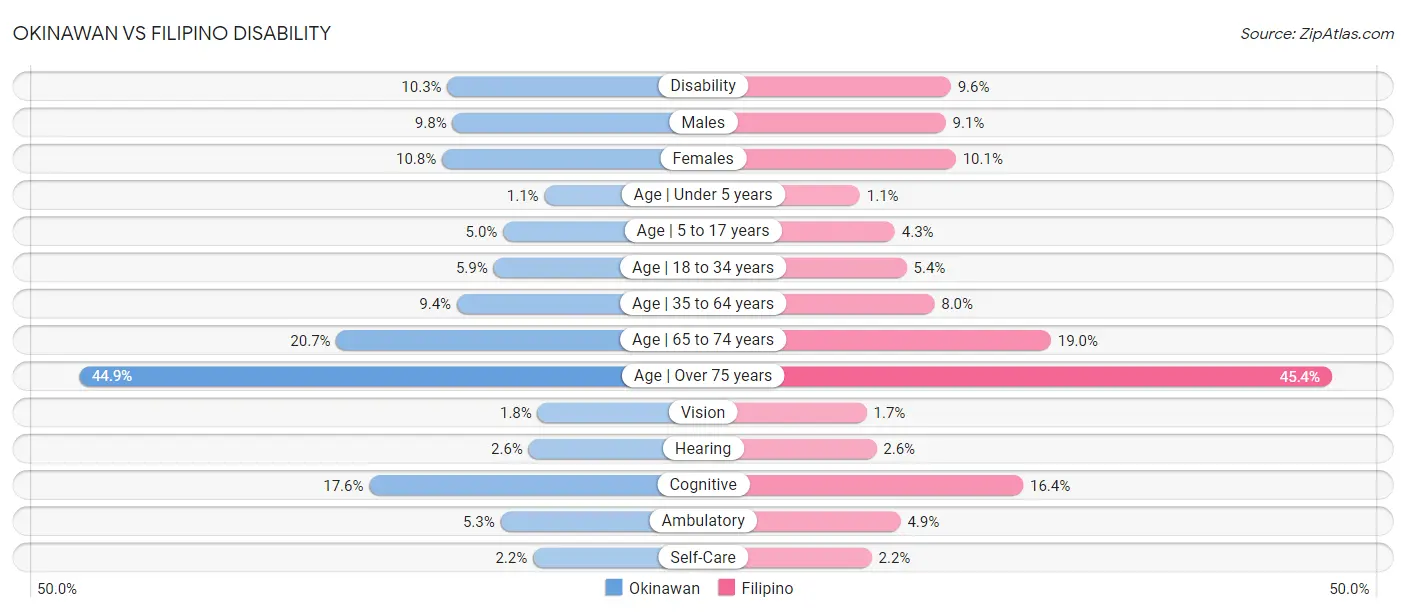
| Disability Metric | Okinawan | Filipino |
| Disability | Exceptional 10.3% | Exceptional 9.6% |
| Males | Exceptional 9.8% | Exceptional 9.1% |
| Females | Exceptional 10.8% | Exceptional 10.1% |
| Age | Under 5 years | Exceptional 1.1% | Exceptional 1.1% |
| Age | 5 to 17 years | Exceptional 5.0% | Exceptional 4.3% |
| Age | 18 to 34 years | Exceptional 5.9% | Exceptional 5.4% |
| Age | 35 to 64 years | Exceptional 9.4% | Exceptional 8.0% |
| Age | 65 to 74 years | Exceptional 20.7% | Exceptional 19.0% |
| Age | Over 75 years | Exceptional 44.9% | Exceptional 45.4% |
| Vision | Exceptional 1.8% | Exceptional 1.7% |
| Hearing | Exceptional 2.6% | Exceptional 2.6% |
| Cognitive | Tragic 17.6% | Exceptional 16.4% |
| Ambulatory | Exceptional 5.3% | Exceptional 4.9% |
| Self-Care | Exceptional 2.2% | Exceptional 2.2% |